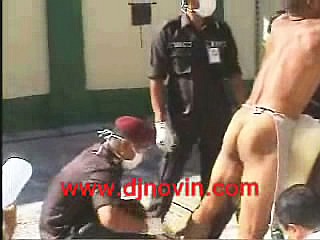JUDICIAL CORPORAL PUNISHMENT

Video clips
Malaysia - judicial caning
Comment and analysis by C. Farrell
With many thanks to the reader who kindly provided the translations from Malay
|
We now have video footage of a genuine judicial punishment session in Malaysia, including several complete canings, ranging from a couple of one-stroke punishments to one of twenty strokes. The video, total running time 22 minutes, is divided into two parts. It was made, probably in 2004, at Seremban prison, not far from Kuala Lumpur. It gives us a comprehensive, uncensored view of JCP being administered in one session to a batch of adult offenders on a production-line basis. For the first time we are given a ringside seat at a dramatic spectacle in which a series of convicted men are made to undergo salutary retribution for their crimes, methodically delivered via their bared buttocks, with the full panoply of the State. material shocking. It is not for the squeamish. You may not want to watch these films if you don't approve of severe corporal punishment for ruthless, violent, adult male criminals. It is your choice. The film opens with a sign reading "Caning Station, Seremban Prison" (Tempat Menjalani Hukuman Rotan Penjara Seremban). We then see prisoners waiting to be caned and being examined by the doctor. The caning operative is shown warming up with a few practice strokes. Each prisoner to be caned is made to wear a sort of pinafore that covers the front but not the rear of his midriff, permitting modesty to be maintained in front while leaving his backside bare. Thus attired, he is brought out to stand in front of the officer in charge, who orders him to state his name and his prisoner number. The OIC then says that his court sentence was X years in prison and Y strokes of the cane. In a number of cases, the OIC asks the prisoner if he understands ("Paham?"), to which all prisoners reply in the affirmative, sometimes adding "Sir" (Tuan). The OIC then says "So this morning we are going to give you X strokes of the cane" (jadi pagi ini kita akan sebat kamu dengan 13 kali sebatan). The prisoner is then taken to the frame and secured to it, and the special buttock-framing torso protection shield is fitted on. When all is ready, another officer, standing at the wall to the right of the frame, shouts out "Punishment of X strokes of the cane", and then calls out the number of each stroke before it is inflicted, just as described in the account by Robert Symes. As also in his description, the session takes place in an open-air compound. The strokes are inflicted at intervals of about 15 seconds. On each stroke, the rotan slices into the prisoner's backside. A raw weal flashes up instantly. Very evident in this film is what is clearly the standard Malaysian practice of having one or more officers holding the prisoner's head from behind the A-frame, just as shown in all the dummy demonstration pictures and stills from filmed reconstructions that we have seen, as well as in the still photo that is almost certainly of a real Malaysian caning in an earlier period before the one-piece torso shield was developed.
The prisoners shown come from all Malaysia's three main races, Malay, Chinese and Indian (identifiable when their names are read out). Oddly, their names have been left on the soundtrack although their visual identity has been obscured. There is no mention in the interviews of what crimes the men committed, or what their ages are. The first four punishments are of only one or two strokes each. This is a typical sentence for relatively minor and non-violent offences such as illegal immigration. Next comes a 13-stroke caning for a Chinese prisoner, which here is split over the first and second parts of the film. He takes his punishment remarkably stoically, hardly moving or making a noise. In the rest of the second clip we see a convict undergoing a rare 20 strokes of the rotan in full. He is a Malay, Azman bin Arsyad. When the OIC tells him that he is now going to get his whipping, the prisoner responds "Thank you, Sir". This man's very heavy punishment takes over five minutes to administer, not counting his interview with the officer in charge immediately beforehand. It appears to be treated even by the prison staff, who are doing this job every week, as a bit of a special event. A new team of officers has taken over. I have the impression that each stroke of this caning is being inflicted with even greater force than for any of the earlier ones. At all events, it is a gruesome sight. This prisoner writhes and struggles, and he shouts quite a bit, including "Allahu Akbar" ("God is great"). By the end of the process his posterior is bleeding freely. But bear in mind that to receive such a sentence he will most likely have committed a truly wicked crime such as, perhaps, the rape of young children. Despite the condition he is in at the end, he manages to limp stiffly back into the building afterwards. There are also remarkable scenes in the prison hospital showing a dozen or so freshly-caned criminals, each lying face down on a bed to receive medical attention. This must mean that there were other canings at the same day's session that were not included in this film. We see close-ups of several of the wounded posteriors. These already look less horrific after receiving first aid than they did immediately at the end of the punishment.
At any rate, it has been claimed anecdotally that films such as this are occasionally shown to older students and/or to juvenile offenders as a warning in Malaysia, as they are known to be in Singapore. And this June 2005 news item reports that "a video of prisoners being whipped" was shown to visitors to an exhibition in Sabah, and that the video had been approved by the Ministry of Home Affairs to deter the public from criminality. Conceivably this was regarded as a substitute for doing the actual flogging in public, which had been mooted in early 2004 for child-rapists, but not proceeded with. (There has never been public JCP in Malaysia or Singapore, or at least not in modern times.) |



 The instant the last stroke is laid on, the officer shouts "habis" ("finished"). In one case we can hear one of the attendants positioned closest to the prisoner at the frame telling him to "take a breath, take a breath" ("tarik nafas").
The instant the last stroke is laid on, the officer shouts "habis" ("finished"). In one case we can hear one of the attendants positioned closest to the prisoner at the frame telling him to "take a breath, take a breath" ("tarik nafas"). Why was this film made? There can be little doubt that it is the same footage as that referred to in
Why was this film made? There can be little doubt that it is the same footage as that referred to in 




No comments:
Post a Comment